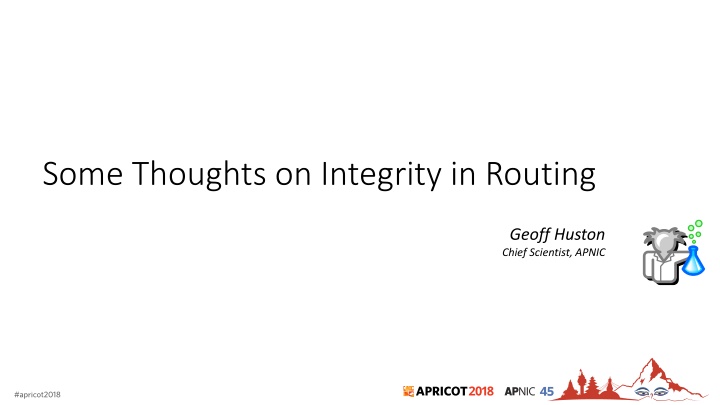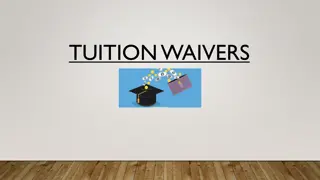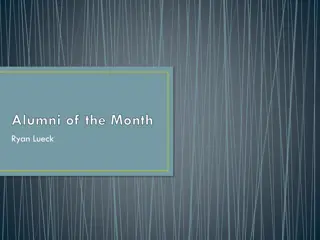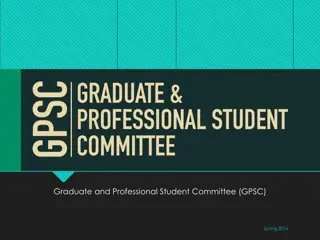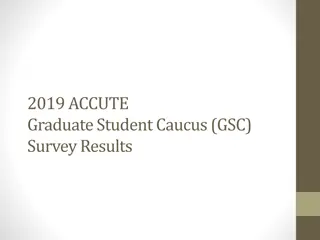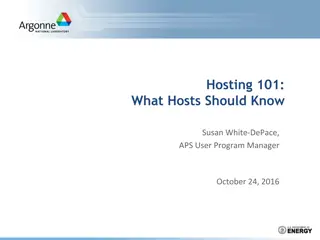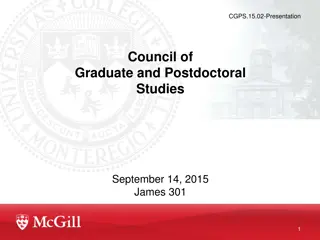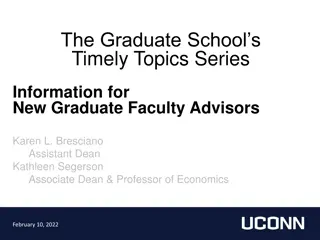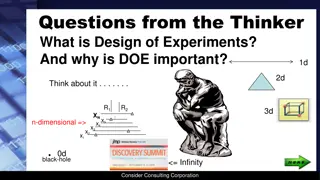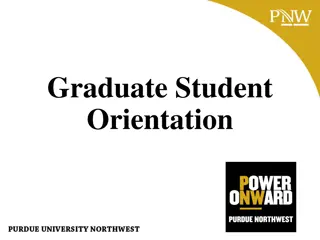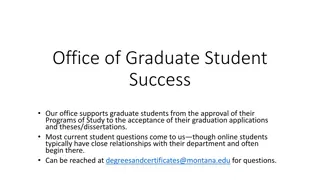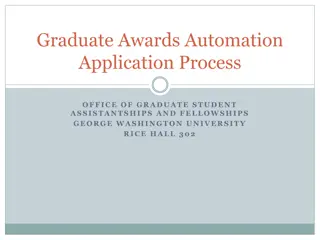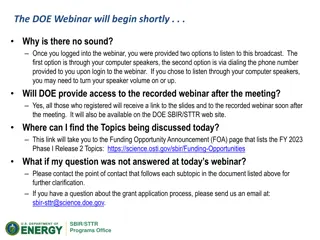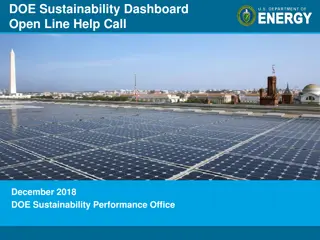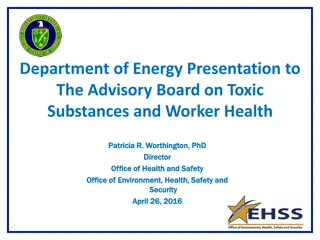DOE Office of Science Graduate Student Research Program
The SCGSR Program offers supplemental awards to exceptional graduate students for conducting part of their doctoral research at a DOE national laboratory. Eligible candidates must align their research with specified priority areas and collaborate with a DOE scientist. Applications must be submitted online, including a research proposal and support letters. Benefits include a monthly stipend and travel reimbursement. Key dates for 2017-2018 solicitations are provided, along with priority research areas such as Advanced Scientific Computing Research, Basic Energy Sciences, Fusion Energy Sciences, and High Energy Physics.
Uploaded on Apr 12, 2025 | 0 Views
Download Presentation

Please find below an Image/Link to download the presentation.
The content on the website is provided AS IS for your information and personal use only. It may not be sold, licensed, or shared on other websites without obtaining consent from the author.If you encounter any issues during the download, it is possible that the publisher has removed the file from their server.
You are allowed to download the files provided on this website for personal or commercial use, subject to the condition that they are used lawfully. All files are the property of their respective owners.
The content on the website is provided AS IS for your information and personal use only. It may not be sold, licensed, or shared on other websites without obtaining consent from the author.
E N D
Presentation Transcript
Some Thoughts on Integrity in Routing Geoff Huston Chief Scientist, APNIC
What we want What we want We want the routing system to advertise the correct reachability information for legitimatelyconnected prefixes at all times That means that we want to avoid: promulgating reachability for bogus address prefixes promulgating incorrect paths for reachable prefixes blocking paths for legitimately connected prefixes
What do we do today? What do we do today? I ask you to route my address prefix You look for these addresses on whois* If it all seems to match then accept the request and add it to the network filters for this customer * As usual, its not as simple as that, as there are a number of whois servers, and you probably have to negotiate across a number of them to get what you are after, or to be assured that the entry is not in any of the registry data collections
What do we do today? What do we do today? I ask you to route my address prefix You look for these addresses on whois If it all seems to match then accept the request and add it to the network filters for this customer * As usual, its not as simple as that, as there are a number of whois servers, and you probably have to negotiate across a number of them to get what you are after, or to be assured that the entry is not in any of the registry data collections
What do we do today? What do we do today? I ask you to route my address prefix You look for these addresses on whois If it all seems to match then accept the request and add it to the network filters for this customer * As usual, its not as simple as that, as there are a number of whois servers, and you probably have to negotiate across a number of them to get what you are after, or to be assured that the entry is not in any of the registry data collections
What do we do today? What do we do today? I ask you to route my net You ask for me to provide a Letter of Authority Which is an effort to absolve you of all liability that may arise from announcing this route You then add the to the network filters for this customer
What do we do today? What do we do today? I ask you to route my net You ask for me to provide a Letter of Authority Which is an effort to absolve you of all liability that may arise from announcing this route You then add the to the network filters for this customer
What do we do today? What do we do today? I ask you to route my net You ask for me to provide a Letter of Authority Which is an effort to absolve you of all liability that may arise from announcing this route You then add the to the network filters for this customer
What do we do today? What do we do today? I ask you to route my net You ask for me to enter the details in a route registry Your routers access filters may be automatically generated from the route registry data that I entered
What do we do today? What do we do today? I ask you to route my net You ask for me to enter the details in a route registry Your routers access filters may be automatically generated from the route registry data that I entered
What do we do today? What do we do today? I ask you to route my net You ask for me to enter the details in a route registry Your routers access filters may be automatically generated from the route registry data that I entered
What do we do today? What do we do today? A publicly accessible description of every import and export I ask you to route my net policy to every transit, peer, and customer, has proved to be extremely difficult to maintain You ask for me to enter the details in a route registry Your routers access filters may be automatically generated from the route registry data that I entered quality of the data in those registries is close to impossible to ascertain. Today, we have many routing registries, not one, and the
Whats the problem here? What s the problem here? None of these approaches are very satisfactory as a complete solution to this problem Let s take a step back and see if we can use digital signature technology to assist here. If we can, then we can construct automated systems that will recognise validly signed attestations about addresses and their use
Registry Role Registry Role The registry plays the role of a neutral third party trust point that can provide an impartial record of which entity is the current holder of an IP address Which is fine for humans, but of limited use to automated systems How can we automate the validation function that allows an entity to validate whether or not a party is the current holder of an IP address? 14
Crypto to the rescue! Crypto to the rescue! Public / Private keys can be really useful here I sign <something> using my private key and send it to you Using my public key you can be assured that: I signed this (and no one else) I cannot deny that I signed it What I signed has not been altered on the way between me and you The assurance can be automated, and does not necessarily rely on a manual process of matching ascii text 15
The RPKI The RPKI If I have the association between a public key and a number block registered by the RIR, then Instead of performing a human match between the registry entry and the party you can get the party to sign an attestation using their local private key If the attestation can be validated by the public key published by the RIR then you have automated the validation function and don t need eyeballs to read web pages to validate the rights of use of IP addresses 16
The RPKI Certificate Service The RPKI Certificate Service Enhancement to the RIR Registry Offers verifiable proof of the number holdings described in the RIR registry Resource Certification is an opt-in service Number Holders choose to request a certificate Derived from registration data
BGPSEC: BGP + RPKI Origination BGPSEC: BGP + RPKI Origination One approach is to look at the process of permissions that add an advertised address prefix to the routing system: The address holder is authorizing a network to originate a route advertisement into the routing system The ROA is a digitally signed version of this authority. It contains An address prefix (and range of allowed prefix sizes) An originating ASN This allows others to check the validity of a BGP route origination: If there is a valid ROA, and the origin AS matches the AS in the ROA, and the prefix length is within the bounds of the ROA, then the announcement has been entered into the routing system with the appropriate permissions
BGPSEC: BGP + RPKI Propagation BGPSEC: BGP + RPKI Propagation In BGP AS Path manipulation is also a problem How can a BGPSEC speaker know that the AS Path in a BGP Update is genuine? Answering this question in BGPSEC gets very messy very quickly! In my opinion:It s highly unlikely that we will see widespread uptake of BGPSEC anytime soon, if ever, largely due to the overheads associated with AS path signing 19
Errrr Errrr why isn t this being adopted by ISPs? why isn t this being adopted by ISPs? Cryptography and Certificate management are operationally challenging: which is often seen as one more thing to go wrong! Validation of signed data is convoluted maybe it should ve been simpler Its not just ROAs you need AS Path protection as well As long as a hijacker includes your ROA-described originating AS in the faked AS PATH then the hijacker can still inject a false route If ROAs are challenging for operators, then BGPsec is far more so!
The Perfect is the Enemy of the Good The Perfect is the Enemy of the Good Maybe there are some Good things we can do right now instead of just waiting for BGPsec to be sorted out!
More Ideas? More Ideas? Waiting for everyone to adopt a complex and challenging technology solution is probably not going to happen anytime soon Are that other things we can do that leverage the RPKI in ways that improve upon existing measures? Use ROAs to digitally sign a LOA? Digitally sign whois entries? Digitally sign Routing Policy descriptions in IRRs Signed data could help a user to determine if the information is current and genuine This would not directly impact routing infrastructure, but instead would improve the operators route admission process to automatically identify routing requests that do not match signed registry / routing database information
What should we do? What should we do? We could keep on thinking about how to make a routing infrastructure that is impervious to attempts to coerce it into false states But it seems that we are not sure how to do this, and not sure who would pay the cost of trying to do this! AND/OR Perhaps we should undertake some focussed work on open BGP monitoring and alarm services that allow us to detect and identify routing issues as they arise, and assist network operators to respond quickly and effectively 23
